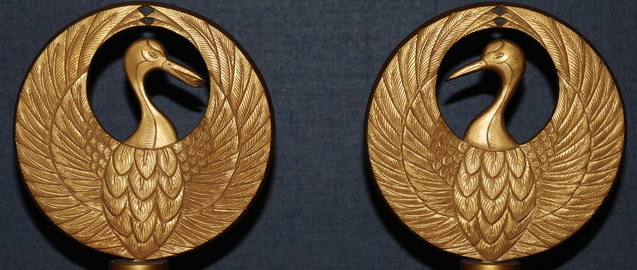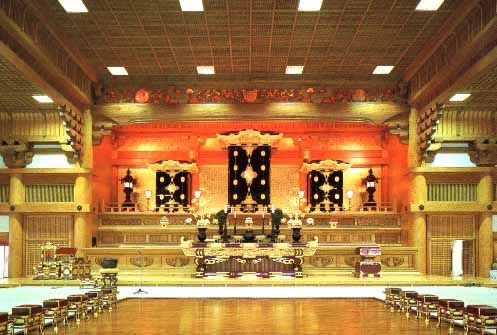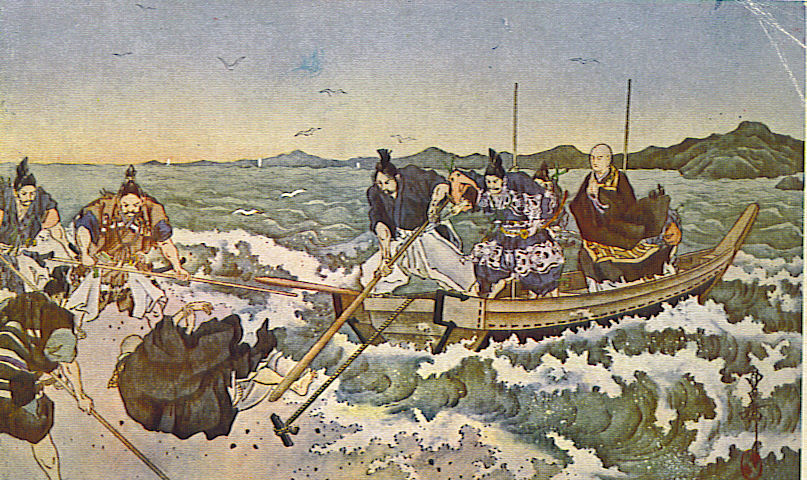|
Taisekiji
, more commonly just , informally known as , is the administrative center of Nichiren Shoshu Buddhism. It is located in the foothills of Mount Fuji in Kamijo, Fujinomiya, Shizuoka Prefecture, Japan. Taiseki-ji was founded in 1290 by Nikkō Shōnin, one of Nichiren Daishonin's senior disciples, on a land parcel donated by the pious believer Daigyo Sonrei, commonly known as Nanjo Tokimitsu (1259–1332). The Head Temple is the home of the Dai Gohonzon, Nichiren Shoshu's object of worship, which draws pilgrim believers from various countries. The temple's open grounds are open to the public for sightseeing, though its religious buildings are restricted only to registered believers. Accordingly, adherents of the Soka Gakkai are not permitted entrance to the Head Temple grounds. Description Taiseki-ji is Nichiren Shoshu's administrative center, and its Chief Priest is simultaneously the high priest () of Nichiren Shoshu. The current 68th High Priest is Nichinyo Hayase (1935 – ... [...More Info...] [...Related Items...] OR: [Wikipedia] [Google] [Baidu] |
Dai Gohonzon
The Dai Gohonzon of the High Sanctuary of the Essential Teachings, commonly known as the Dai Gohonzon (Japanese: 大 御 本 尊 ''The Supreme (Great) Gohonzon'' or Honmon—Kaidan—no—Dai—Gohonzon, Japanese: 本 門 戒 壇 の 大 御 本 尊) is a venerated mandala image inscribed with both Sanskrit and Chinese logographs on a median log trunk of Japanese camphorwood. The image is worshipped in Nichiren Shoshu Buddhism, which claims to possess within both the Dharma teachings and Tamashi of Nichiren as inscribed by him on wood, then carved by his artisan disciple Izumi Ajari Nippo. The High Priests of Nichiren Shoshu copy and transcribe their own rendition of the image, which is loaned to the followers of the sect. Due to its accorded sacrosanct nature, the mandala can only be audienced to registered Hokkeko believers. The image was first explicitly mentioned in the last will and testament of Nikko Shonin for his designated successor Nichimoku, annually displayed ... [...More Info...] [...Related Items...] OR: [Wikipedia] [Google] [Baidu] |
Nichiren Shōshū
is a branch of Nichiren Buddhism based on the traditionalist teachings of the 13th century Buddhism in Japan, Japanese Buddhist Bhikkhu#Monks in Japan, priest Nichiren (1222–1282), claiming him as its founder through his senior disciple Nikko Shonin (1246–1333), the founder of Taiseki-ji, Head Temple Taiseki-ji, near Mount Fuji. The lay adherents of the sect are called Hokkeko members. The Enichizan Myohoji Temple in Los Angeles, California, serves as the temple headquarters within the United States. The sect is known for vehemently rejecting the various forms of Buddhism taught by Shakyamuni Buddha as incomplete, expired and heretical for the Three Ages of Buddhism, Third Age of Buddhism. Instead, the sect is based on the exclusivist teachings of Nichiren and the chanting of "Nam-Myoho-Renge-Kyo" along with reciting curated portions of the Lotus Sutra. The object worshipped by its believers is the ''Dai Gohonzon'' while its religious symbol is the rounded crane bird. Bot ... [...More Info...] [...Related Items...] OR: [Wikipedia] [Google] [Baidu] |
Nikkō Shōnin
, Buddhist name , was one of the six senior disciples of Nichiren and was the former Chief Priest of Kuon-ji temple in Mount Minobu, Japan. Various Nichiren sects in Japan claim to have been founded by Nikkō, the most prominent being Nichiren Shōshū and some lineages within Nichiren Shū. Nikkō kept meticulous records and highly organized religious practice during his lifetime, and is responsible for much of the records that survive today. Nikkō singularly upheld the doctrine that Nichiren was the ''True and Eternal Buddha'' in the Third Age of Buddhism and therefore is considered by schools stemming from Nikkō such Nichiren Shōshū and the Soka Gakkai as the legitimate successor to the ministry and legacy of Nichiren. Nikko established the Head Temple Taisekiji at Fujinomiya in 1290, as well as enshrining the Dai Gohonzon image. In 1332, four months before his death, he designated Nichimoku Shonin as his successor. The grave of Nikkō remains today in Kitayama Honm ... [...More Info...] [...Related Items...] OR: [Wikipedia] [Google] [Baidu] |
Ushitora Gongyo
is a Buddhist liturgy service conducted in Nichiren Shōshū, Nichiren Shōshū Buddhism. The service is traditionally held at 2:30 AM at the Taiseki-ji#Kyakuden, Kyakuden building of Taiseki-ji, Taisekiji Head Temple, located within the lower slopes of Mount Fuji, Japan. It is the morning prayer service which is indirectly offered to the Dai Gohonzon image, approximately one mile away from a distance area in accordance to the sect and beliefs of wide propagation. The Buddhist sect claims that the reputed ceremony has been rigidly observed for over 700 years without fail, since the death anniversary of Nikkō Shōnin on 7 February 1333. Overview Among Nichiren Shōshū believers, several pious customs and folk beliefs are often associated with the reputedly auspicious hours of the daylight prayer service: * The hours mark the transitional time range when Shakyamuni Buddha entered the state of Nirvana under the Bodhi tree. * Pious beliefs which claim that between these auspici ... [...More Info...] [...Related Items...] OR: [Wikipedia] [Google] [Baidu] |
Mount Fuji
is an active stratovolcano located on the Japanese island of Honshu, with a summit elevation of . It is the highest mountain in Japan, the second-highest volcano on any Asian island (after Mount Kerinci on the Indonesian island of Sumatra), and List of islands by highest point, seventh-highest peak of an island on Earth. Mount Fuji Hōei eruption, last erupted from 1707 to 1708. It is located about southwest of Tokyo, from where it is visible on clear days. Its exceptionally symmetrical cone, which is snow field, covered in snow for about five months of the year, is a Japanese cultural icon and is frequently depicted in art and photography, as well as visited by sightseers, hikers and mountain climbers. Mount Fuji is one of Japan's along with Mount Tate and Mount Haku. It is a List of Special Places of Scenic Beauty, Special Historic Sites and Special Natural Monuments, Special Place of Scenic Beauty and one of Japan's Monuments of Japan, Historic Sites. It was added to th ... [...More Info...] [...Related Items...] OR: [Wikipedia] [Google] [Baidu] |
Nichiren Daishonin
was a Japanese Buddhist priest and philosopher of the Kamakura period. His teachings form the basis of Nichiren Buddhism, a unique branch of Japanese Mahayana Buddhism based on the ''Lotus Sutra''. Nichiren declared that the ''Lotus Sutra'' alone contains the highest truth of Buddhism and that it is the only sutra suited for the Age of Dharma Decline. He insisted that the sovereign of Japan and its people should support only this form of Buddhism and eradicate all others, or they would face social collapse and environmental disasters. Nichiren advocated the faithful recitation of the title of the ''Lotus Sutra'', ''Namu Myōhō Renge Kyō'', as the only effective path to Buddhahood in this very life, a path which he saw as accessible to all people regardless of class, education or ability. Nichiren held that Shakyamuni and all other Buddhist deities were manifestations of the Original Eternal Buddha (本仏 ''Honbutsu'') of the ''Lotus Sutra'', which he equated with the ''L ... [...More Info...] [...Related Items...] OR: [Wikipedia] [Google] [Baidu] |
Soka Gakkai
is a Japanese new religions, Japanese new religion led by Minoru Harada since December 2023 based on the teachings of the 13th-century Buddhist priest Nichiren. It claims the largest membership among Nichiren Buddhism, Nichiren Buddhist groups. The organization bases its teachings on Nichiren's interpretation of the ''Lotus Sutra'' and places chanting Namu Myōhō Renge Kyō, Nam Myōhō Renge Kyō at the center of devotional practice. The organization promotes its goals as supporting "peace, culture, and education". Soka Gakkai was founded by educators Makiguchi and Toda on 18 November 1930, and held its inaugural meeting in 1937. It was disbanded during the Second World War when much of the leadership was imprisoned for violations of the Peace Preservation Law#Public Security Preservation Law of 1925, 1925 Peace Preservation Law and charges of lèse-majesté. After the war, its expansion was led by its former third president Daisaku Ikeda. In Japan, Soka Gakkai is the head ... [...More Info...] [...Related Items...] OR: [Wikipedia] [Google] [Baidu] |
Nichiren By Kano Tsunenobu (Honmonji)
was a Japanese Buddhist priest and philosopher of the Kamakura period. His teachings form the basis of Nichiren Buddhism, a unique branch of Japanese Mahayana Buddhism based on the '' Lotus Sutra''. Nichiren declared that the '' Lotus Sutra'' alone contains the highest truth of Buddhism and that it is the only sutra suited for the Age of Dharma Decline. He insisted that the sovereign of Japan and its people should support only this form of Buddhism and eradicate all others, or they would face social collapse and environmental disasters. Nichiren advocated the faithful recitation of the title of the ''Lotus Sutra'', ''Namu Myōhō Renge Kyō'', as the only effective path to Buddhahood in this very life, a path which he saw as accessible to all people regardless of class, education or ability. Nichiren held that Shakyamuni and all other Buddhist deities were manifestations of the Original Eternal Buddha (本仏 ''Honbutsu'') of the ''Lotus Sutra'', which he equated with the ' ... [...More Info...] [...Related Items...] OR: [Wikipedia] [Google] [Baidu] |
Fujinomiya, Shizuoka
is a city located in central Shizuoka Prefecture, Japan. , the city had an estimated population of 132,507 in 56,655 households, and a population density of 340 persons per km2. The total area of the city is . History The city name comes from the former shrine name of Fujisan Hongū Sengen Taisha, "Fujinomiya". It is an ancient settlement that developed as a prosperous ''toriimae-machi'' (town in front of torii) of Fujisan Hongū Sengen Taisha, where the Fuji clan served as the high priest of the shrine. Nearby is the sanctuary of Taiseki-ji temple, founded in 1290 by Nikkō Shōnin as the headquarters of Nichiren Shōshū Buddhism. Fujinomiya is closely related to Mount Fuji, and was located in the crossroad of Ōmiya and Murayamaguchi mountain pilgrimage trails. During the Kamakura period, the hunting event Fuji no Makigari arranged by shogun Minamoto no Yoritomo was held in the ancient region of Fujino, where the Revenge of the Soga Brothers incident also took place ... [...More Info...] [...Related Items...] OR: [Wikipedia] [Google] [Baidu] |
Nichiren
was a Japanese Buddhist priest and philosopher of the Kamakura period. His teachings form the basis of Nichiren Buddhism, a unique branch of Japanese Mahayana Buddhism based on the '' Lotus Sutra''. Nichiren declared that the '' Lotus Sutra'' alone contains the highest truth of Buddhism and that it is the only sutra suited for the Age of Dharma Decline. He insisted that the sovereign of Japan and its people should support only this form of Buddhism and eradicate all others, or they would face social collapse and environmental disasters. Nichiren advocated the faithful recitation of the title of the ''Lotus Sutra'', '' Namu Myōhō Renge Kyō'', as the only effective path to Buddhahood in this very life, a path which he saw as accessible to all people regardless of class, education or ability. Nichiren held that Shakyamuni and all other Buddhist deities were manifestations of the Original Eternal Buddha (本仏 ''Honbutsu'') of the ''Lotus Sutra'', which he equated with t ... [...More Info...] [...Related Items...] OR: [Wikipedia] [Google] [Baidu] |
Sunrise
Sunrise (or sunup) is the moment when the upper rim of the Sun appears on the horizon in the morning, at the start of the Sun path. The term can also refer to the entire process of the solar disk crossing the horizon. Terminology Although the Sun appears to "rise" from the horizon, it is actually the ''Earth's'' motion that causes the Sun to appear. The illusion of a moving Sun results from Earth observers being in a rotating reference frame; this apparent motion caused many cultures to have mythologies and religions built around the geocentric model, which prevailed until astronomer Nicolaus Copernicus formulated his heliocentric model in the 16th century. Architect Buckminster Fuller proposed the terms "sunsight" and "sunclipse" to better represent the heliocentric model, though the terms have not entered into common language. Astronomically, sunrise occurs for only an instant, namely the moment at which the upper limb of the Sun appears tangent to the horizon. However, th ... [...More Info...] [...Related Items...] OR: [Wikipedia] [Google] [Baidu] |









